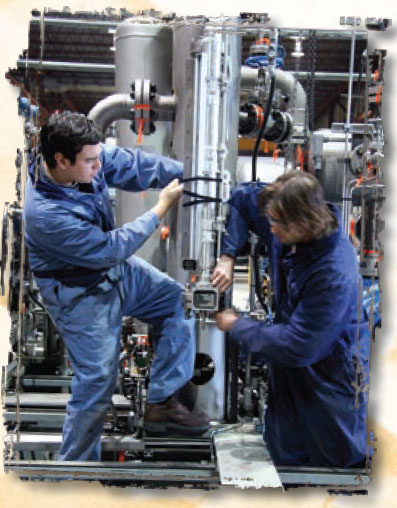Safety

Basic Oil and Gas Safety Training
Purpose of this Training Course:
The Essential qualification in the Oil & Gas industry is Safety. The knowledge and training in safety is a mandatory condition for an Oil professional.
Objective:
The objectives of this SHALE training course are to enhance knowledge of Fundamental of the Oil and Gas Safety system.
Who is this Training Course for?
In general, for Everyone in the Oil field
- Engineers
- Technicians
- Skilled helpers
- Contractors
Day One: Oil & Gas Safety
- Introduction / PPE
- Abbreviation and Definitions
- Safe & Unsafe Act /Conditions
- Toolbox talk / Chemical handling
- Health safety
- Physical hazard
- Hazard controls
Day Two: Permit system
- Hot work / Cold work
- Naked Flame / Work at height
- Safety Isolation certificates
- SIMOPS / Documentation
Day Three: Basic First Aid
- Basic First Aid
- Emergency Response
Day Four: Fire fighting
- Fire classification
- Types of Extinguishers
- Firefighting procedures
- Firefighting Equipment handling
- Deluge system
Day Five: Hydrogen Sulphide (H2S)
- Introduction
- Properties / Tolerance limits
- Effect and Danger of H2S
- Escape equipment / Methods
- Breathing Apparatus (BA)
NDT Training course
Purpose of this Training Course:
SHALE is created by Oil & Gas / NDT professionals who wanted to provide the highest level of NDT training, for the young Engineers, Technicians who are interested to develop their career in Oil & Gas industry. Our courses offer hands-on learning, top-of-the-line equipment, and NDT Level III instructors who are still active in the field, giving you real non-destructive testing experience. We specialize in NDT Level I and NDT Level II courses, giving you everything you need to enter or advance in your field.
This SHALE training course will highlight:
- Piping
- QA/QC
- NDT Level II
- Magnetic Particle Testing (MT)
- Penetrant Test (PT)
- Ultrasonic Testing (UT)
- Radiographic Testing and Film Interpretation (RT & RTFI)
Objective:
Non-destructive Testing plays an important role in the integrity and safety of many infrastructures and industries. To ensure the effectiveness of testing and repairs, all technicians are required to earn NDT certifications in a range of testing methods. Training involves three stages: classroom learning, examinations, and on-the-job training. SHALE fulfils the classroom learning and examination requirements but doesn’t offer on-the-job training. Attendees must complete this part of their training and certification outside of our training program
Who is this Training Course for?
- Mechanical Engineers
- Maintenance Technicians
- Diploma Engineers (Mechanical)
- Inspection Technician
- ITI qualified
How will this Training Course be Presented?
Participants to this SHALE training course will receive a thorough training on the subjects covered by the seminar outline with the Tutor utilising a variety of proven adult learning teaching and facilitation techniques. Seminar methodology includes classroom-style with highly interactive, exercise and case studies the training course will be run using PowerPoint slide and video.

Training Course Duration
- 4 Weeks
Week One: Piping and QA/QC
- Introduction Drilling, Exploration & Refining / EPC
- Isometric drawing / P&ID / GAD / Safety
- Drawing Calculations Symbols, codes & Standard
- QA/QC Introduction / Welding Position & Symbols Defectology
- Welding Process / Heat treatment / Documentation (WPS, PQR, ITP, WQT)
- Boiler / Metallurgy
Week Two: NDT Level II / Penetrant Test (PT)
- Visual testing
- Liquid penetrant testing
- Magnetic particle testing
- Ultrasonic testing
- Radiographic testing
- Radiographic film Interpretation
- PT Introduction / Basic Principles / Steps of PT / Classifications
- Types of Penetrants / Types of Cleaning / Developer Types / Post Cleaning Methods
- Dwell time of Penetrants and Developers / Fluorescent Methods
- Blacklight and White light / Devices
- Indication Development, Interpretation and Evaluation / Safety
- Sensitivity rank of Developers and Penetrants
- Brief of ASME Section V Article 6 / Practical and Report Samples
Week Three: Magnetic Particle Testing
- Introduction / Method Selection
- Basics of Magnetism / Types of Magnetic Fields / Types of Magnetizations
- Dry and Wet Methods / Wet, Visible and Fluorescent Methods
- Magnetic Particles Concentration and Conditions / Field Indicators, Pi Gauge,
- Slotted Strips / Light Measurements / Demagnetization / Hysteresis Loop
- Introduction to ASME / Section V / Practical / Interpretation, Evaluation and Sample Reports
Week Four: Ultrasonic Testing (UT) / RT & RTFI
- Introduction / Basics of Sound / Basic Principle of UT
- Working Principle / Design and Construction of Probes / Types of Transducers
- Calibration Methods (V1 block, V2 block, and DAC blocks) / Inspection Methods and Calibration / Data Presentation / Practical (Calibration of Normal, Angle Probe and Inspection of Test Pieces)
- Basics of RT / Review of RT variables / Difference between X-Ray and Gamma-Ray Devices / Intensity, Penetration, and Material Thickness / Source Selection for Gamma-Ray Technique
- Radiographic Techniques, SFD, Exposure Time
- Exposure Time Calculations, Film Factor, RHM / RT Film Types, Variables, Handling, Screens, Speed, Density, Exposure and Equivalent Film Classes / Penetrameter – Types, Selection, and Placement
- Film Viewing – Illuminator, Film ID, Location Marker, Densitometer / RT Image Quality – Sensitivity, Contrast, Definition, Unsharpness, Backscattering / Film Processing
- Course, Procedures, and Written Practices
- RT Safety Aspects, Measuring Devices, Exposure Limits, and Protection / Practical